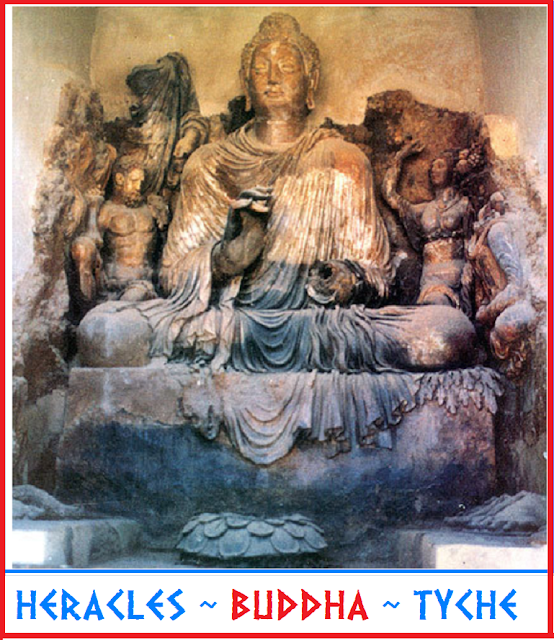Alexander the Great campaigned to India in 328 BCE. He left behind Greek forces in India, establishing the first Hellenistic populations near the Ganges and opening up the east to Greek immigration. Around 180 BCE, a Greco-Bactrian king, Demetrius, invaded India. It was the start of what would come to be known as the Indo-Greek Kingdom, a cluster of dynasties that would cover the northwestern parts of the Indian subcontinent for roughly the next hundred years. The last Indo-Greek king died in 10 BCE. But long after the Greek Kings left, their legacy remained.
Their system of coinage was adopted by contemporary Buddhist kingdoms. Kings also followed Hellenic fashions in numismatics, such as having themselves represented in profile on coins, with legends, which carry the year of minting and other details, in Greek characters forming a halo around their heads.
The Greek language continued to appear on coins during Kushan rule, from 1 to 4 CE, and the Greek script appeared for centuries afterwards.The Indians were influenced by the Greeks, since they were exposed to so much of their culture, philosophy, art, and architecture. The artists who worked in Bactria also worked in Gandhara as well.
We can see the influence of Greek artists on Indian sculptures in that region. Buddhist sculptors were either Greeks or learned from the Greeks. The same people worked in Bactria and Gandhara and we can see that by comparing the art on the coins, because both places had the same Indo-Greek monarch.
All the Buddhist sculptures of the 3rd century BCE depicted Buddha in the form of a symbol, such as a Dharma Chakra (Wheel of the Dharma), a throne, a pair of footprints or a Bo (or bodhi or papal) tree. It was only in the Hellenistic era that the Buddha was shown in a human form. . The earliest statues, in fact, may have been idealised versions of King Demetrius himself. Some historians have placed these early statues in the western tradition of representing the man-god in human form, much like the Gods of Greece.
Gandhara and Mathura Schools of Art
Both Gandhara and Mathura schools of art became well-known as centers of Buddhist sculptures. One of the main characteristics of this style of art was the anthropomorphic representation of Buddha and Bodhisattvas, especially in its sculptural manifestations. In both Gandhara and Mathura, human images of the Buddha began to appear at about the same time, but can be distinguished from one another. The Mathura images resemble Indian male fertility gods, with shorter, curlier hair and lighter, more transluscent robes. They also are not shown to be as sensual as their Gandhara counterparts.
The Gandhara school is different from the Mathura school because of the heavy influence of Hellenistic features. The figures are clearly inspired by Greek figures, as they have similar wavy hair texture and heavily pleated, body-hugging garments. The Hellenistic ideal human form was slender with visible muscles. The ideal body type to them was one of a Greek athlete who was very fit. The heavily pleated garments on these bodies were inspired by Greek dress styles.The Buddha of the Gandhara school has wavy hair and a long nose set in an oval face. The drape of his garment recalls the togas of Hellenistic sculpture, the divine figure often acquires humanistic details such as jewellery and a moustache. Since these were among the earliest anthropomorphic images of the Buddha, the Gandhara school has been influential in how he came to be depicted.
Human representations of the Buddha were made centuries after his death. Therefore, certain attributes, such as the elongated earlobes and the ushnisha on top of his head were used to identify him when he was made in human form. The ushnisha on his head was modeled after Greek hairstyles from Hellenistic times. This concept of characteristic features was a Hellenistic tradition, as the Greeks created symbols to represent their divinities and heroes. The Nimbus or aureole indicated on the figures represent a transcendent status which was similar to solar deities. Buddha was modeled after Apollo, the Greek God of the sun. It was also through image sizes that certain characters were deemed to be more important than others.
Greek art styles have influenced India as a whole and there is definitely abundant evidence that proves that.
Edited from prinseps.com and scroll.in






















Amazing Greek history !
ReplyDelete